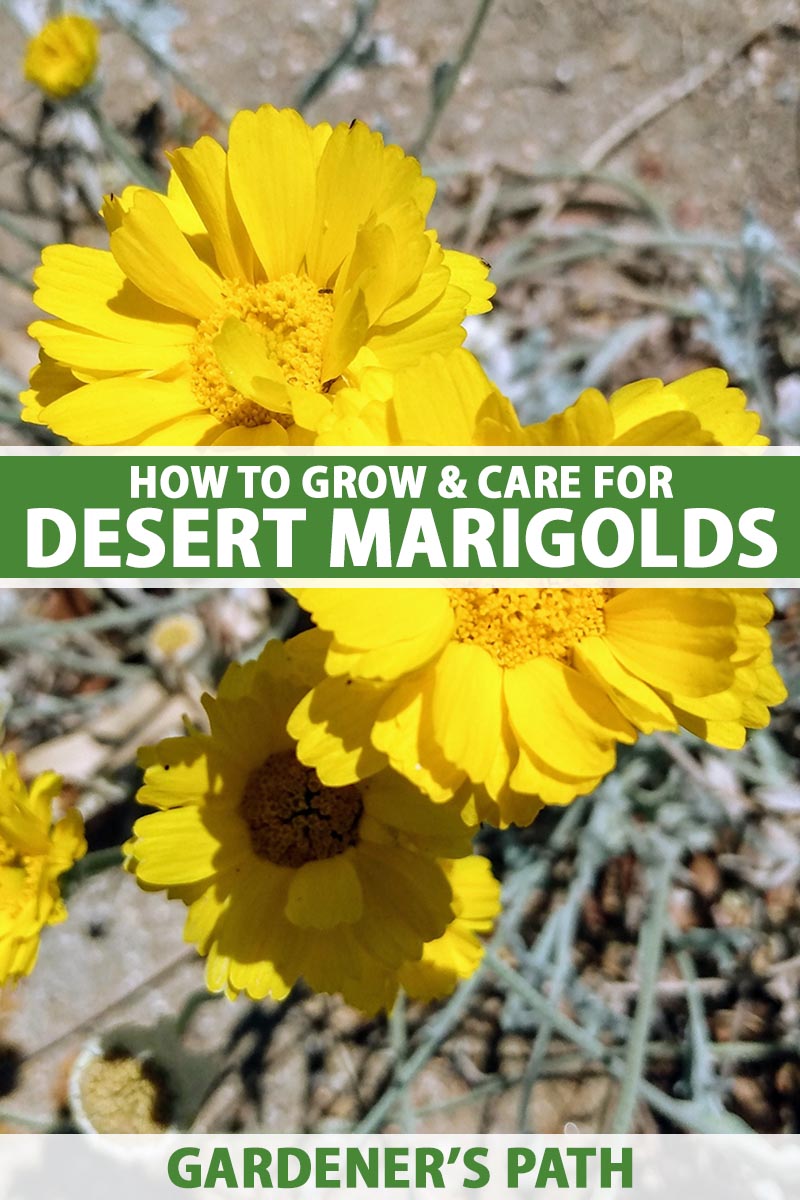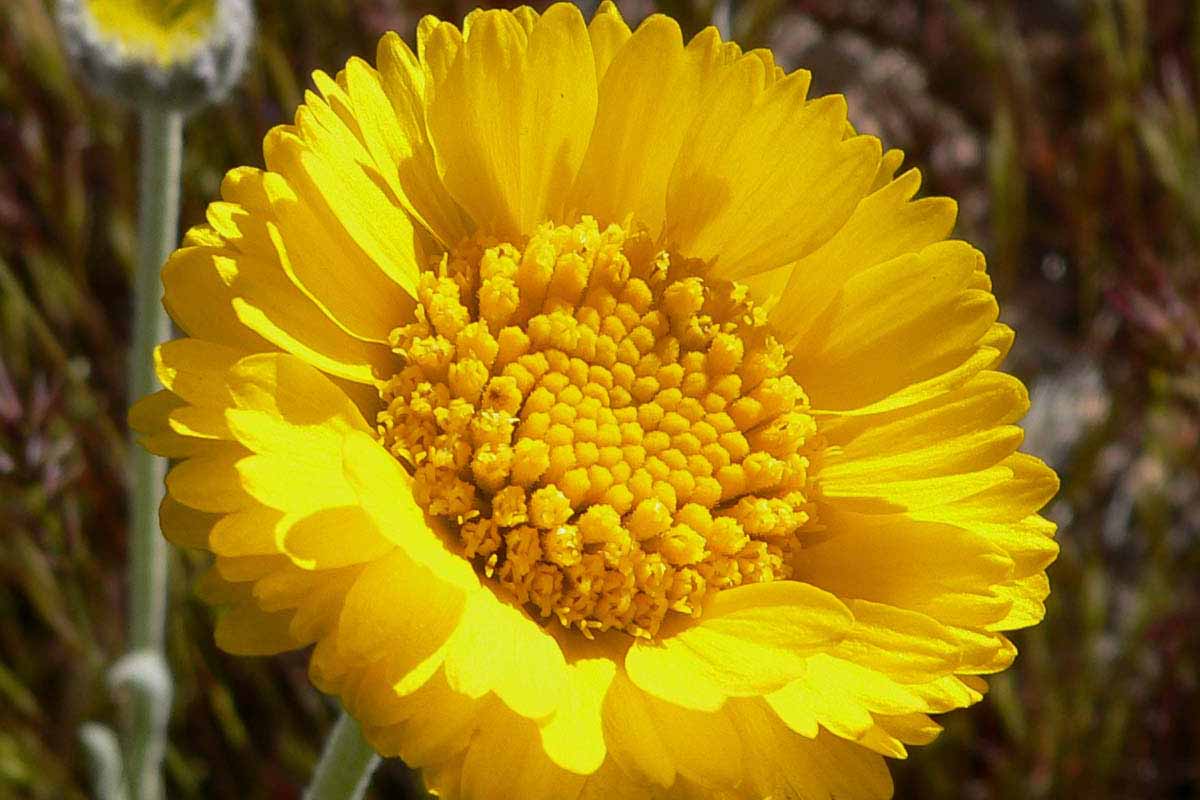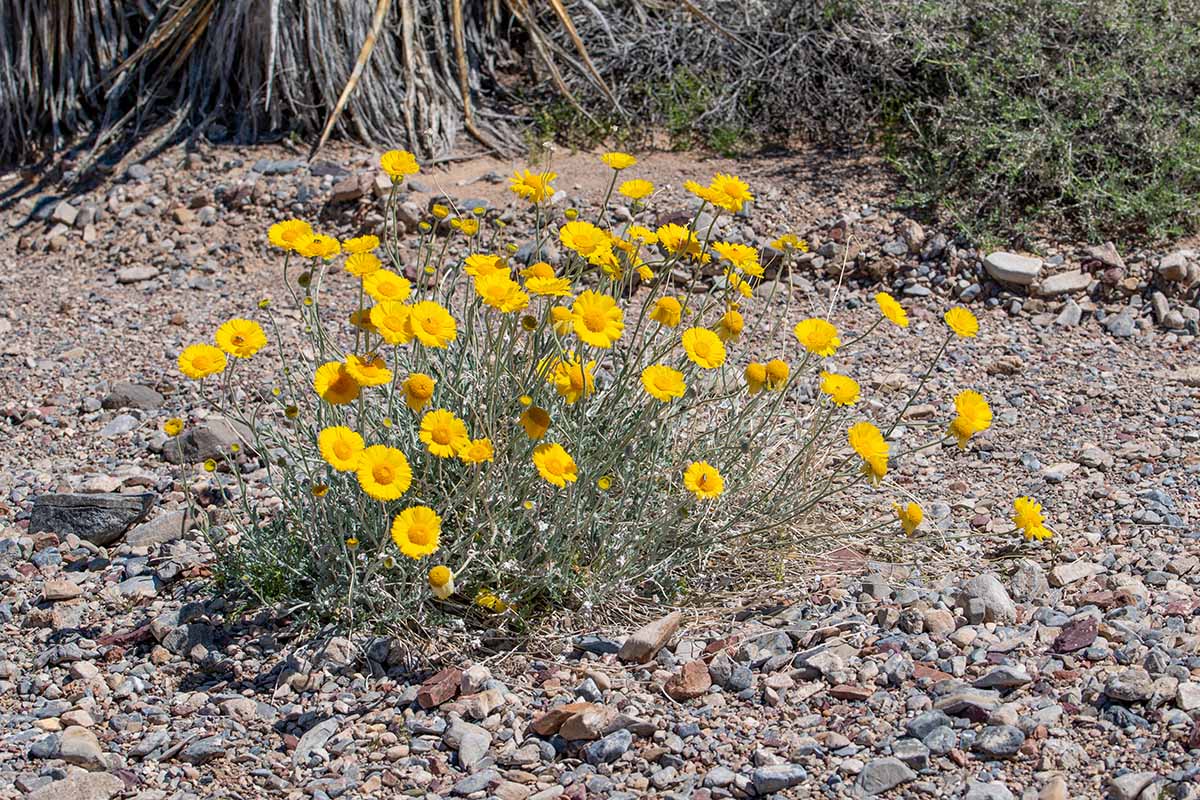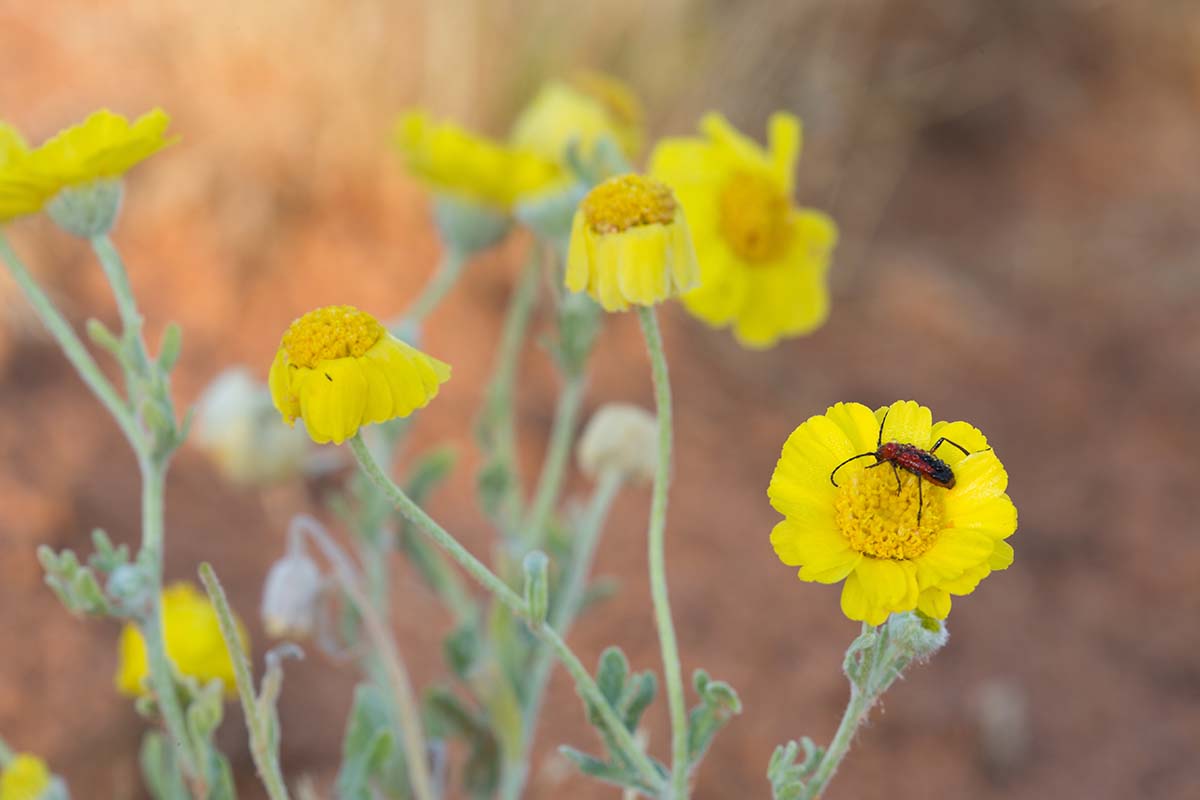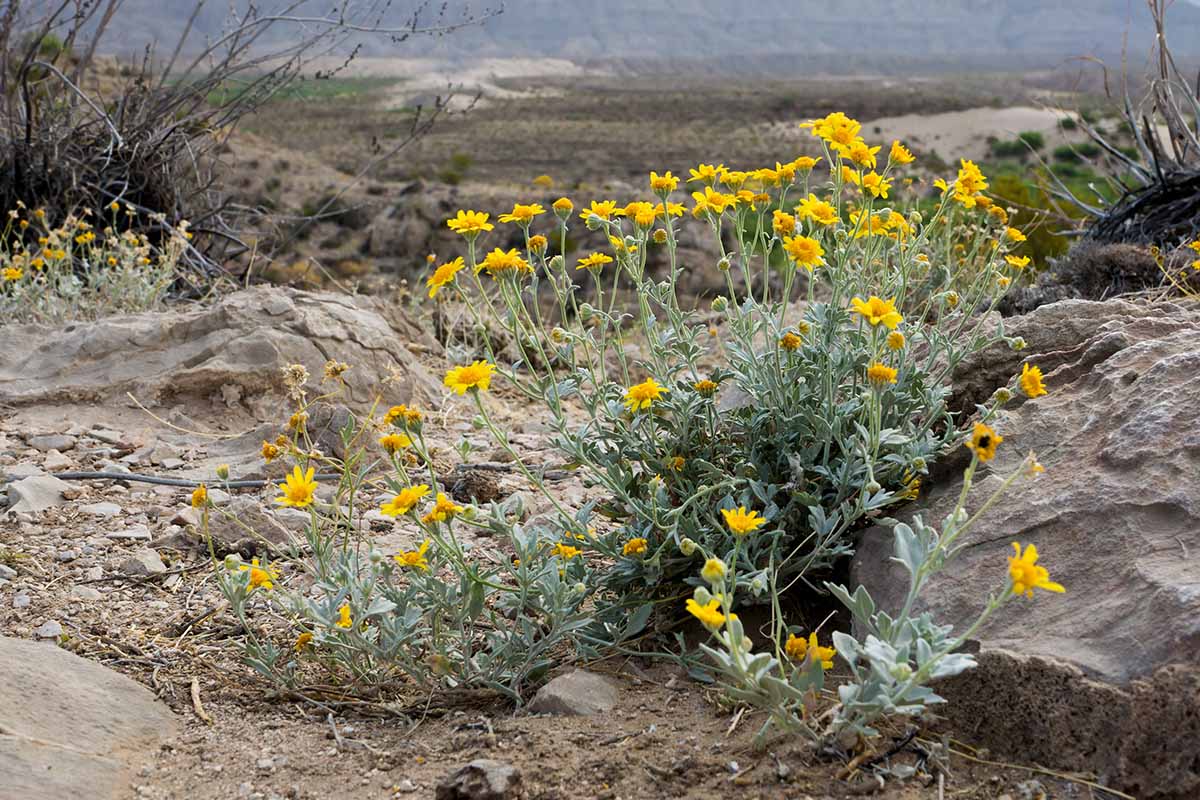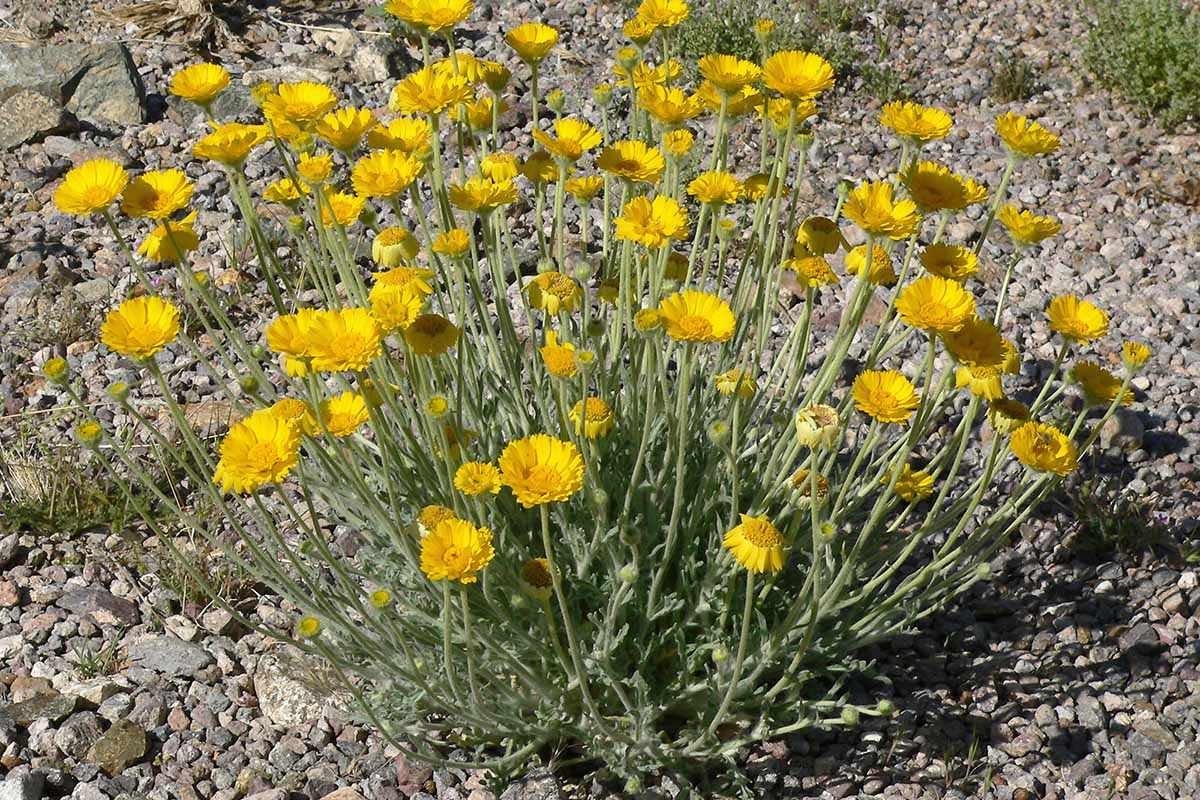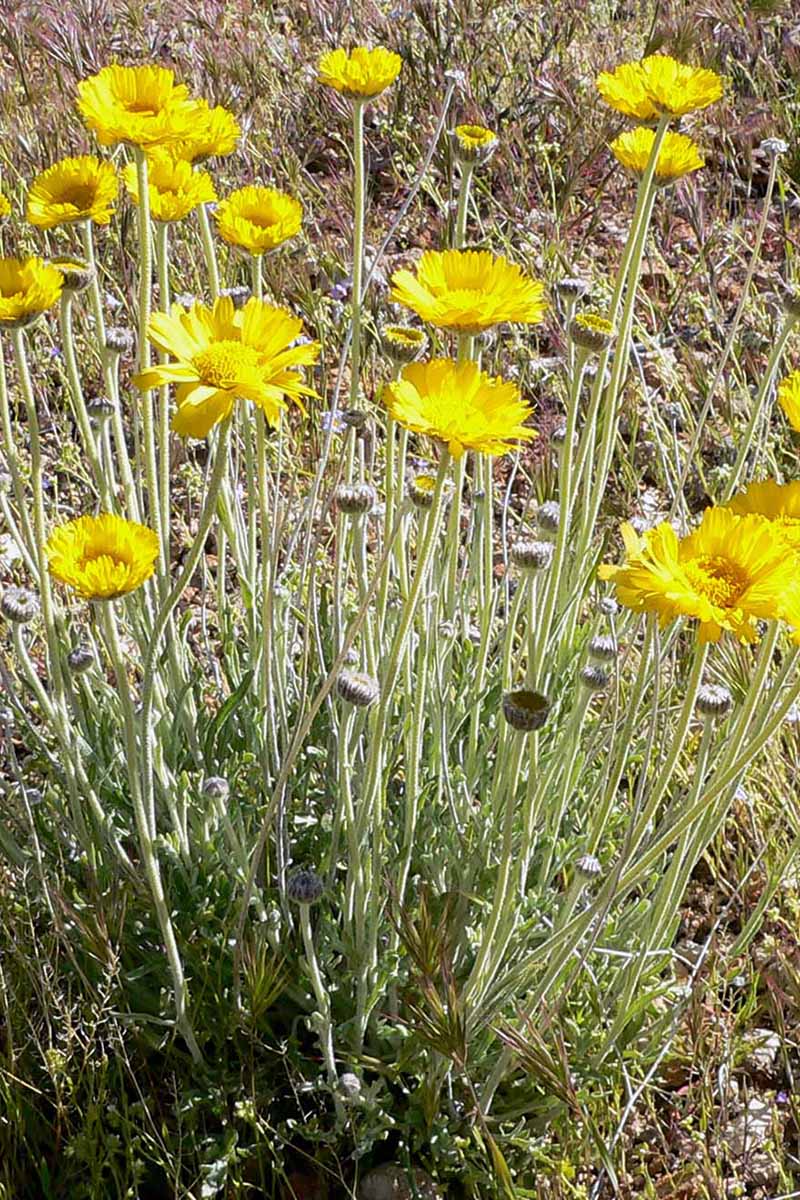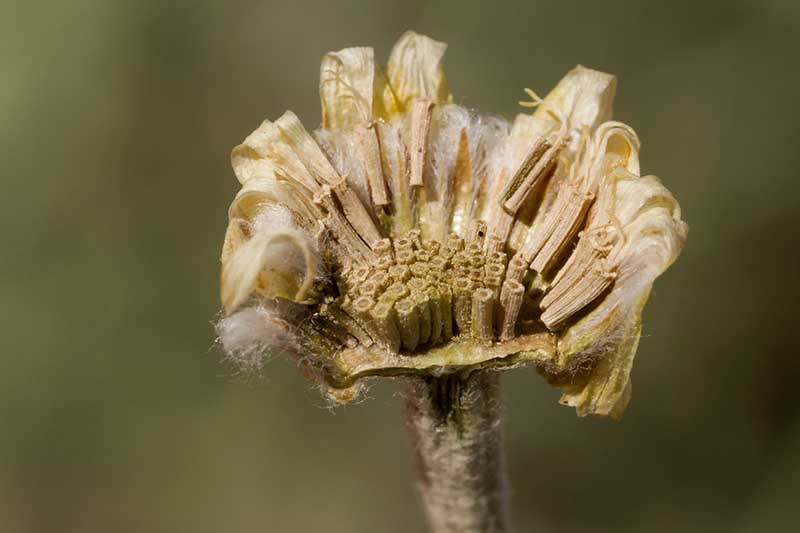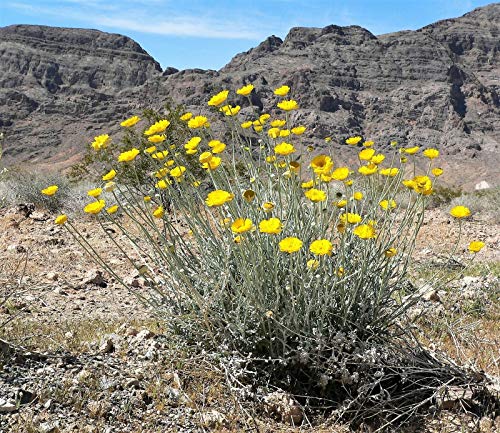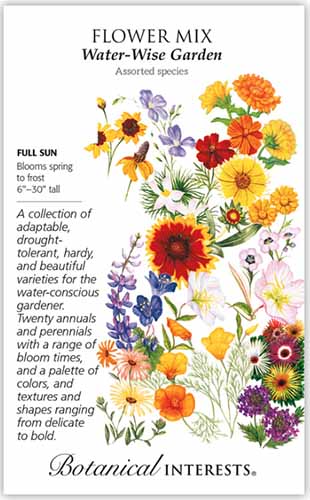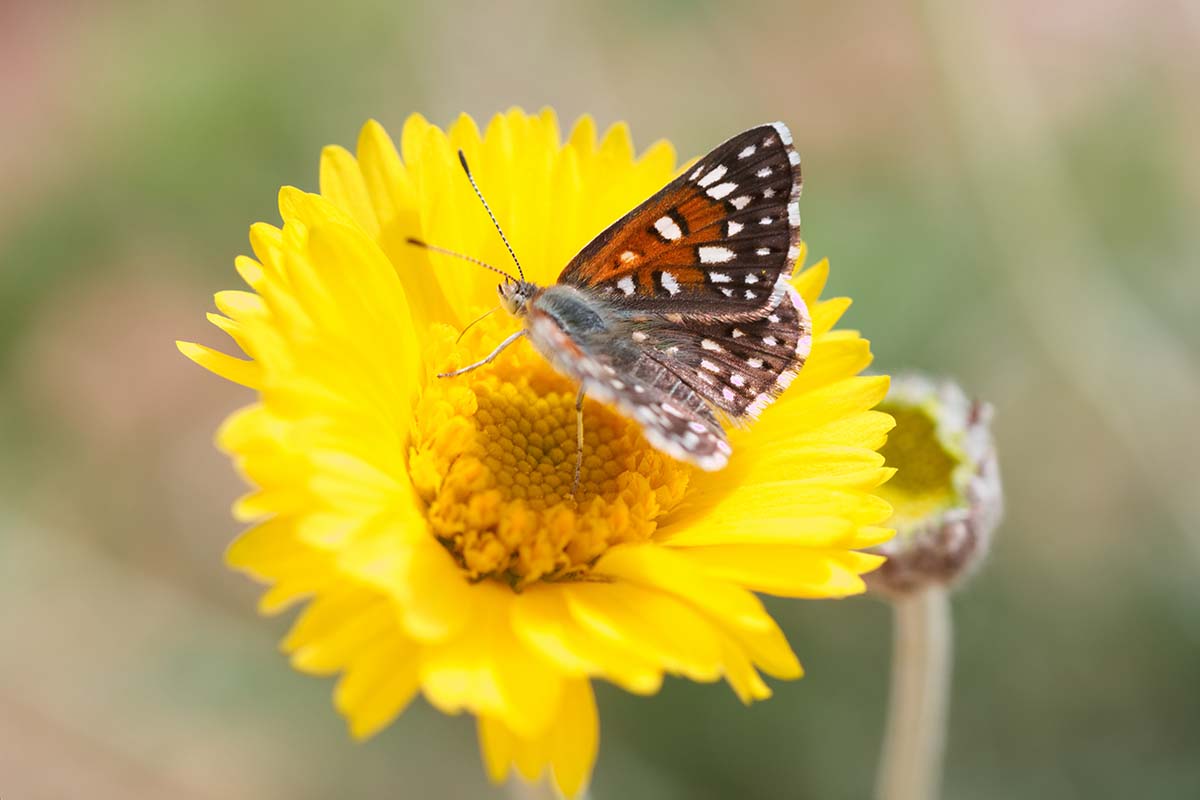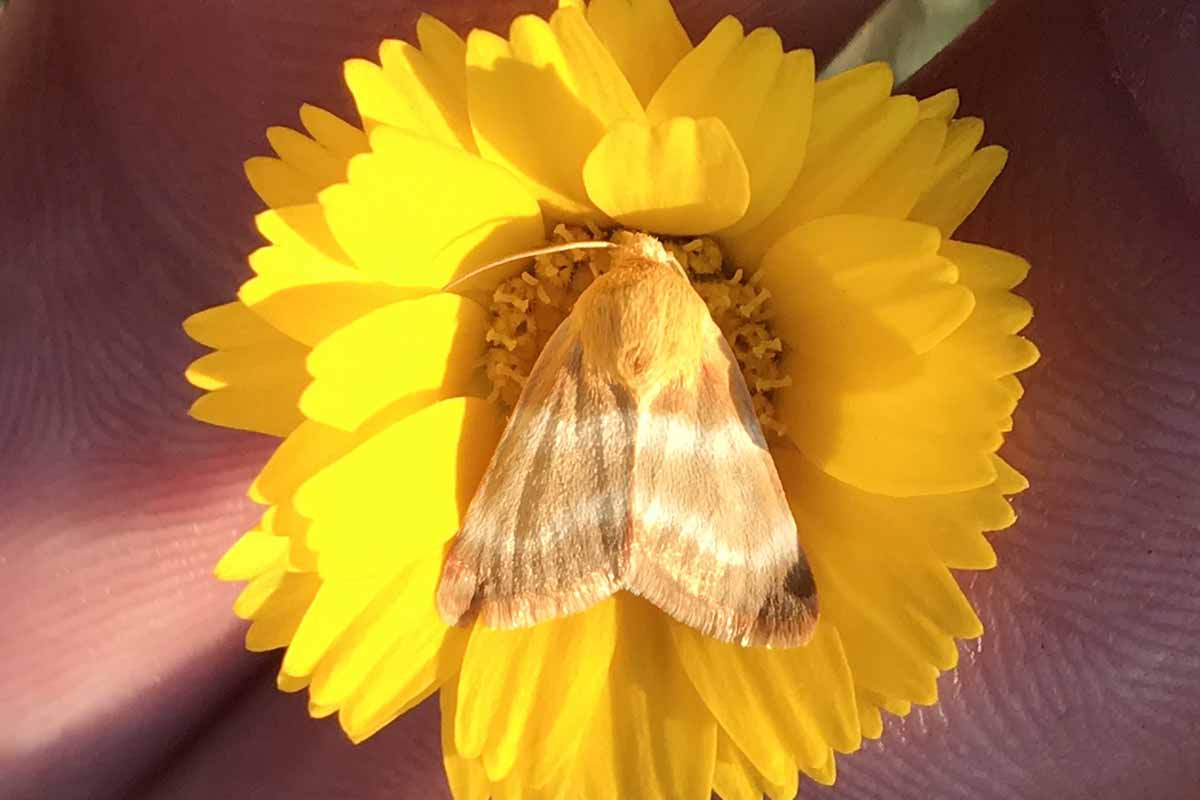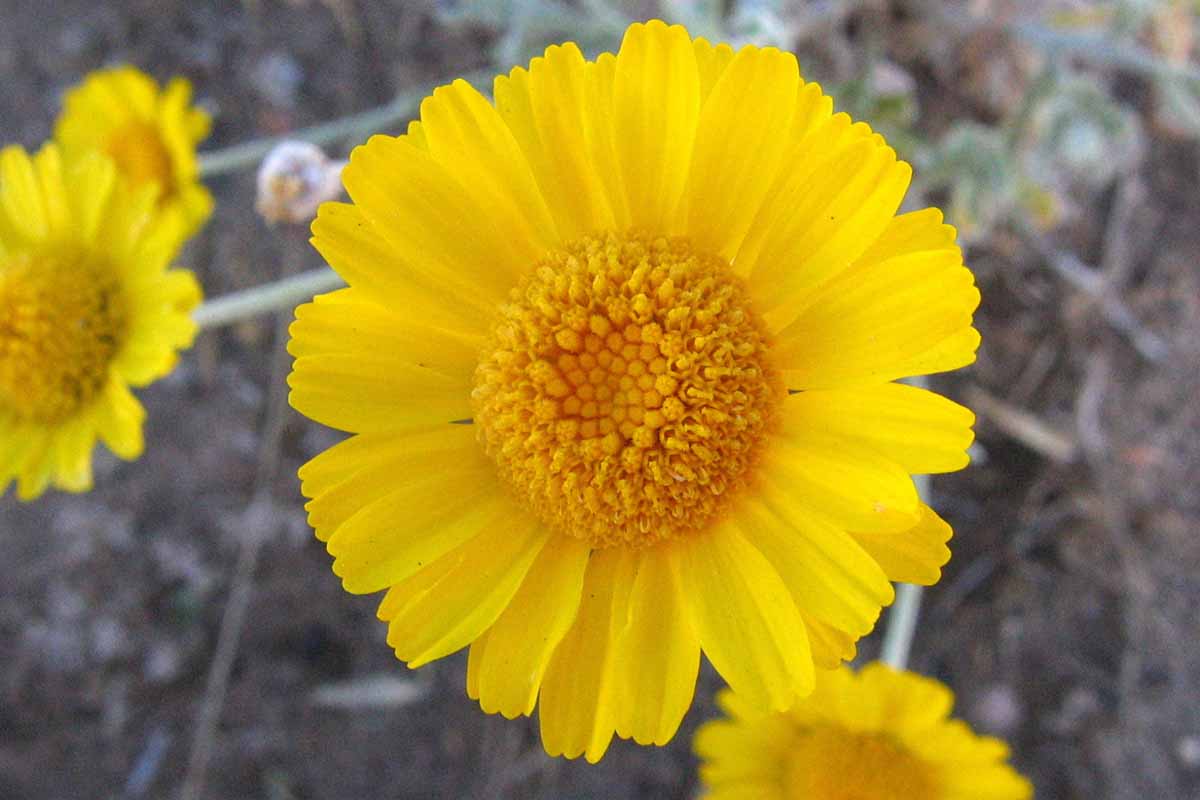This drought-tolerant native of the American Southwest can provide an eco-friendly – and beautiful – alternative to thirsty bedding annuals for those in hot, dry locations. We link to vendors to help you find relevant products. If you buy from one of our links, we may earn a commission. Natives, by definition, are well-adapted to the climate, soil, and rainfall of their original range – making them lower maintenance and easier to care for than non-native species. The subject of our article is one such native of the arid southwest region. It provides beauty for gardeners as well as bounty for local pollinators, all while demanding little in return. We’re going to discuss everything you’ll need to know to grow this lovely and resilient wildflower in your own landscape. Ready for a sneak peek? Here’s everything you’ll find up ahead:
What Is Desert Marigold?
Classified botanically as Baileya multiradiata, desert marigold is an herbaceous perennial adapted to hot, dry landscapes. In springtime, these wildflowers start producing a cycle of blooms that can continue all the way through to autumn, depending on water availability. This wildflower’s yellow flowers measure one to two inches across, and have wide centers and multiple layers of scalloped petals. These are held aloft above a basal rosette of deeply lobed alternate leaves. The basal rosette reaches about six inches in height. An adaptation to its native range, this wildflower has grayish-green foliage that reflects hotter wavelengths of sunlight, helping to keep the plant cool. Another adaptation to arid climates – the plant’s foliage is covered with wooly hairs. These plants have an upright, mounding, and spreading growth habit, reaching eight to 24 inches tall and 24 to 30 inches wide. Height will vary depending on rainfall and elevation. This species tolerates cold temperatures ranging down to about 10°F. Growing best in arid locations within USDA Hardiness Zones 7b to 10b, B. multiradiata may be considered an annual, biennial, or short-lived perennial depending on the local growing conditions, with a lifespan of one to five years.
Cultivation and History
Desert marigold is native to arid desert areas of northern Mexico and the southwestern United States. It is found in both the Sonoran Desert and the Mojave. In the wild, it may be found in various habitats including semi-desert grasslands, interior chaparral communities, and desert scrub, as well as desert washes, rocky slopes, and in disturbed areas such as roadsides. A member of the Asteraceae family, B. multiradiata is distantly related to the Tagetes marigolds and calendula (also known as “pot marigolds”), as well as to other wildflowers native to North America such as goldenrod, echinacea, and joe-pye weed. The genus Baileya is named for chemist and botanist Jacob Whitman Bailey, while the species name multiradiata means “many ray flowers,” referring to the blooms’ multiple layers of petals. Baileya is a genus that includes only three members, all of which originate in the southwestern US and Mexico. The other two species are laxflower (B. pauciradiata) and wooly desert marigold (B. pleniradiata). The subject of our article, B. multiradiata, is also known as “showy desert marigold,” “paper daisy,” and “desert baileya.” And although this wildflower could stand on its looks alone, it also has a history of ethnobotanical use, including being incorporated into adobe and plaster, as well as being used as a deodorant! However, attention should be taken to keep this species away from some types of livestock – it’s toxic to both goats and sheep.
Propagation
Paper daisy is easily propagated via seed. We’ll look at the process for direct sowing this wildflower as well as some tips for getting potted transplants into the ground.
Direct Sowing
Paper daisy can be sown in either spring or in fall – and in both cases, gardeners should plan to seed heavily to account for low germination rates. If sowing in fall, seeds can be sown in place. For spring sowings, stratify seeds in moist sand in the fridge for two to three weeks before sowing. When ready to sow, prepare the soil by removing weeds from the area. There’s no need to mix in fertilizer or compost – this species does best in lean conditions. Level the soil in the growing area, then scrape back a small amount of soil. Place groups of seeds two to two and a half feet apart, cover with a quarter of an inch of soil, then water in lightly. For fall plantings, don’t provide supplemental irrigation until the spring. For spring plantings, water infrequently and only as needed. Seedlings may need slightly more irrigation than established specimens, depending on local conditions, but take care not to overwater. We’ll talk more about this species’ water needs shortly, so keep reading. Once seedlings are established, thin to one plant every two to two and a half feet.
From Transplants
When transplanting desert marigolds into the landscape, dig a hole that is about twice as wide as the nursery pot and about an inch deeper. Remove the transplant from its pot and rub your hands along the edges of the root ball, to loosen the roots. Remove some of the soil from the specimen’s roots. Mix the soil from the nursery pot with the soil you removed from the hole, and place a little of this in the bottom of the hole. Situate the specimen in the hole so the top of its root ball is level with the soil surface, adjusting the amount of soil beneath the root ball if needed. Fill in around the roots with the soil you removed earlier. Water in your transplant. If there’s insufficient rainfall, water more frequently than you would mature plants for the first month or so to help it get established.
How to Grow
This plant will be most rewarding when cultivated in the right climate and provided with the tough conditions it is adapted to. B. multiradiata should be grown in full sun in coarse, sandy, or rocky soil that drains quickly. This species tolerates alkaline soils and grows best within a pH range of 7.0 to 9.0. As for water, in the wild this desert dweller can survive with as little as 1.8 inches of water per year, and as much as 19 inches. So using those numbers as a reference point and depending on the amount of rainfall in your area, provide irrigation as needed, but remember to take care not to overwater. A rain gauge can help to determine the amount of precipitation you’ve received. During the heat of summer, these wildflowers can go dormant, but will continue blooming if provided with rain or supplemental irrigation.
Growing Tips
Plant in full sun.Grow in rocky or sandy soil with fast drainage.Provide minimal irrigation as needed.
Pruning and Maintenance
As a resilient native species, when grown in its natural desert climate, this wildflower will require little, if any, maintenance. This species doesn’t require fertilizer – it’s adapted to growing in lean soils. Skip organic mulches such as pine bark or leaf compost, which will create conditions that are too humid for this dryland species. But don’t hesitate to mulch around this plant with rock or gravel. Mulching can help plants overwinter more successfully in addition to slowing water loss and preventing weeds from gaining a foothold during the growing season. The flowers of this native species can be deadheaded, but why not leave them and enjoy them? Their faded petals will become papery, providing interest throughout fall and winter, and their seeds will supply food for local bird populations. And when seeds drop to the ground, they can easily produce new plants. However, if you prefer to keep your landscape free of volunteers, you can always deadhead the spent blooms. In areas where B. multiradiata perennializes, cut the established plant back to three to six inches in late winter to remove dead foliage and encourage new growth. This wildflower is more of a pollinator magnet than a pest magnet. And it is not prone to disease as long as it’s grown in the arid conditions it prefers. Instead, look for transplants at local native plant sales or make inquiries at the local chapter of your native plant society. Seeds, on the other hand, can be a bit easier to find. Desert Marigold Seeds Water-Wise Flower Mix You might also like the Water-Wise Flower Mix, a selection of seeds from Botanical Interests that includes drought-tolerant species like B. multiradiata in combination with 18 other varieties.
Managing Pests and Disease
One of the benefits of landscaping with natives is that these species tend to be well adapted to their local conditions and less likely to succumb to pests and diseases. Such is the case with B. multiradiata! When drainage is inadequate or irrigation is too heavy-handed, both root rot and crown rot can be problems. However, prevention is easy! Just limit irrigation, grow in fast-draining soil, and don’t bother trying to grow this species in wet, humid locations. If you’re starting to realize that your conditions aren’t really suitable for this dryland wildflower and you need some suggestions for native plants that will work in your climate, check out our article on 15 of the best native wildflowers for the US and Canada.
Best Uses
As long as it’s incorporated into landscapes where it won’t be too coddled, paper daisy can be used in a multitude of ways, making a waterwise and low maintenance plant for arid climates. This species can be used for mass plantings, incorporated into xeriscapes and rock gardens, or included in cut flower gardens. It can also be planted near walls, where it will thrive in the reflected heat. It will naturalize easily, and can grow on slopes and along roadsides, helping to stabilize inclines and prevent erosion in such locations. And as a native species, it can be incorporated into a native wildflower landscape or wildlife garden. Use it to attract pollinators such as native bees and other beneficial insects, or include it in a low-water butterfly garden. Moths also love this species, and it’s a host to the desert marigold moth (Schinia miniana), which forms unique, round cocoons over the flower heads. Just make sure you plant it in a well-suited locale, and take care not to give it too much love (in the form of water), and this wildflower will embellish your landscape with its mounds of golden blooms. What are your own plans for this showy wildflower? If you’ve cultivated this plant in your landscape before, does it grow as a perennial, annual, or biennial for you? And do you have any of your own tips you’d like to share with our readers? If so, let us know in the comments section below! Looking for other heat-loving desert species for your landscape? You’ll find more right here:
How to Grow Turpentine Bush: the Desert DazzlerPrettier Than Its Namesake: How to Grow Bat-Faced CupheaHow to Grow and Care for Agave in the Garden
